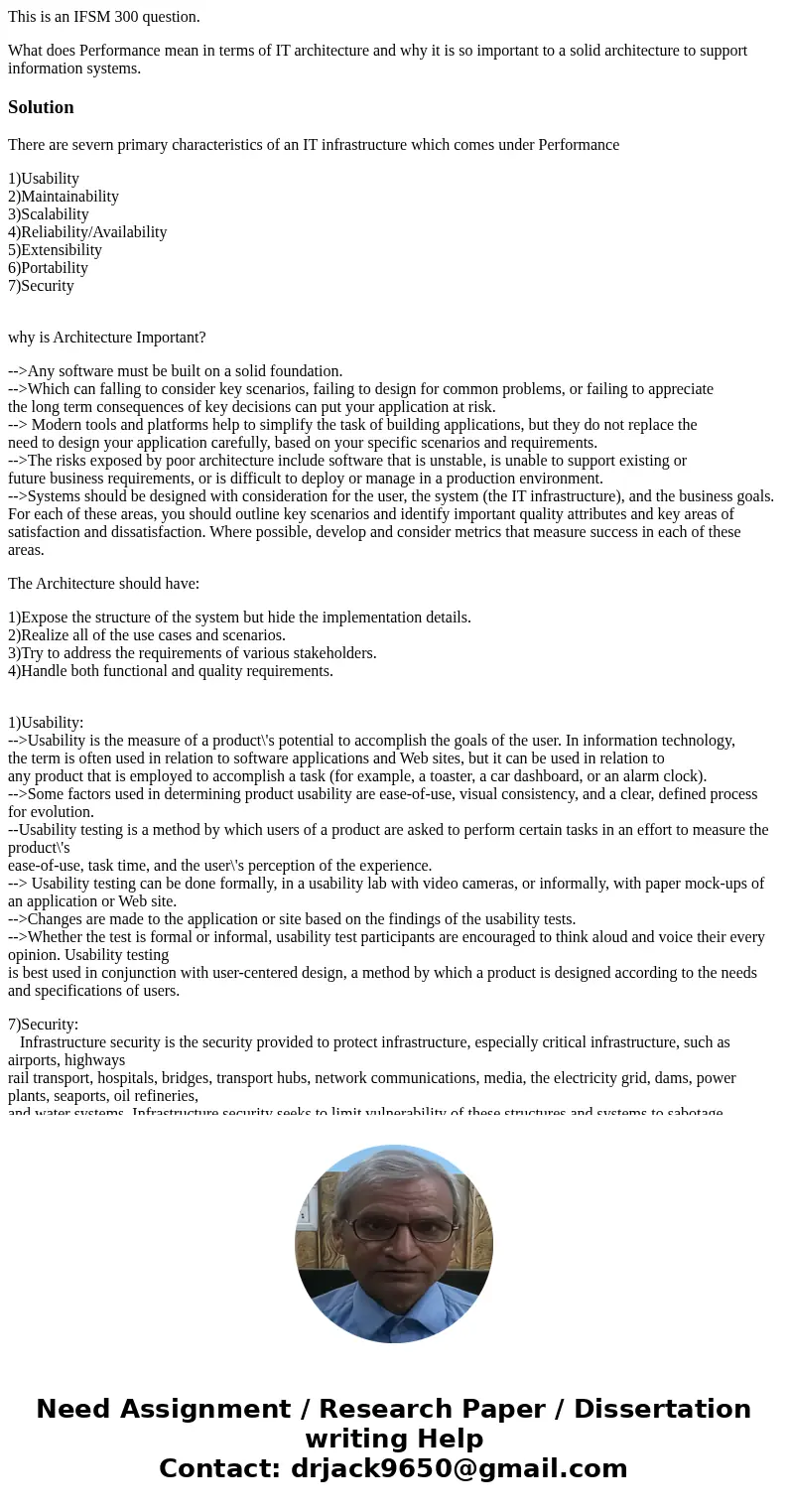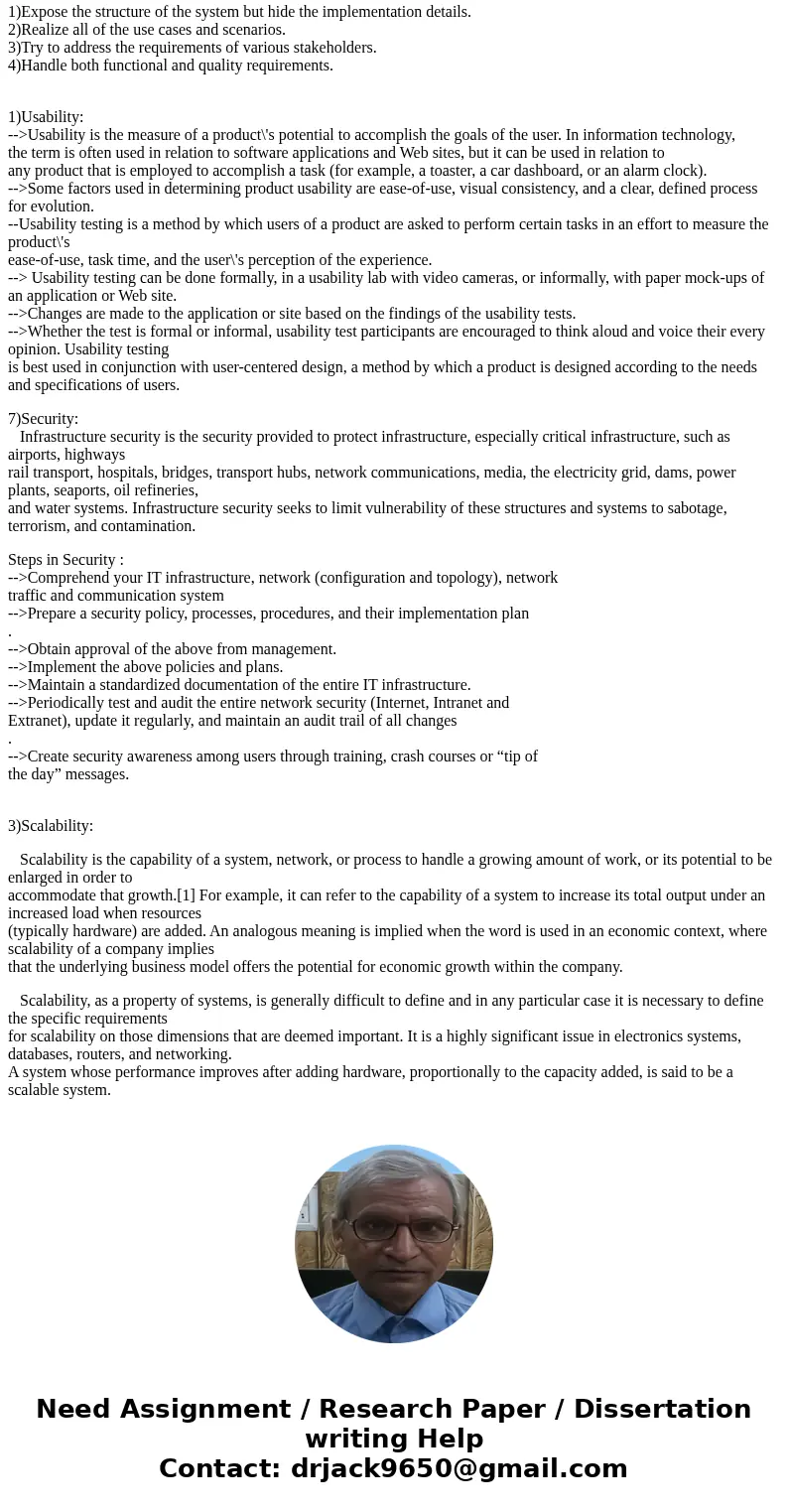This is an IFSM 300 question What does Performance mean in t
This is an IFSM 300 question.
What does Performance mean in terms of IT architecture and why it is so important to a solid architecture to support information systems.
Solution
There are severn primary characteristics of an IT infrastructure which comes under Performance
1)Usability
2)Maintainability
3)Scalability
4)Reliability/Availability
5)Extensibility
6)Portability
7)Security
why is Architecture Important?
-->Any software must be built on a solid foundation.
-->Which can falling to consider key scenarios, failing to design for common problems, or failing to appreciate
the long term consequences of key decisions can put your application at risk.
--> Modern tools and platforms help to simplify the task of building applications, but they do not replace the
need to design your application carefully, based on your specific scenarios and requirements.
-->The risks exposed by poor architecture include software that is unstable, is unable to support existing or
future business requirements, or is difficult to deploy or manage in a production environment.
-->Systems should be designed with consideration for the user, the system (the IT infrastructure), and the business goals.
For each of these areas, you should outline key scenarios and identify important quality attributes and key areas of
satisfaction and dissatisfaction. Where possible, develop and consider metrics that measure success in each of these areas.
The Architecture should have:
1)Expose the structure of the system but hide the implementation details.
2)Realize all of the use cases and scenarios.
3)Try to address the requirements of various stakeholders.
4)Handle both functional and quality requirements.
1)Usability:
-->Usability is the measure of a product\'s potential to accomplish the goals of the user. In information technology,
the term is often used in relation to software applications and Web sites, but it can be used in relation to
any product that is employed to accomplish a task (for example, a toaster, a car dashboard, or an alarm clock).
-->Some factors used in determining product usability are ease-of-use, visual consistency, and a clear, defined process for evolution.
--Usability testing is a method by which users of a product are asked to perform certain tasks in an effort to measure the product\'s
ease-of-use, task time, and the user\'s perception of the experience.
--> Usability testing can be done formally, in a usability lab with video cameras, or informally, with paper mock-ups of an application or Web site.
-->Changes are made to the application or site based on the findings of the usability tests.
-->Whether the test is formal or informal, usability test participants are encouraged to think aloud and voice their every opinion. Usability testing
is best used in conjunction with user-centered design, a method by which a product is designed according to the needs and specifications of users.
7)Security:
Infrastructure security is the security provided to protect infrastructure, especially critical infrastructure, such as airports, highways
rail transport, hospitals, bridges, transport hubs, network communications, media, the electricity grid, dams, power plants, seaports, oil refineries,
and water systems. Infrastructure security seeks to limit vulnerability of these structures and systems to sabotage, terrorism, and contamination.
Steps in Security :
-->Comprehend your IT infrastructure, network (configuration and topology), network
traffic and communication system
-->Prepare a security policy, processes, procedures, and their implementation plan
.
-->Obtain approval of the above from management.
-->Implement the above policies and plans.
-->Maintain a standardized documentation of the entire IT infrastructure.
-->Periodically test and audit the entire network security (Internet, Intranet and
Extranet), update it regularly, and maintain an audit trail of all changes
.
-->Create security awareness among users through training, crash courses or “tip of
the day” messages.
3)Scalability:
Scalability is the capability of a system, network, or process to handle a growing amount of work, or its potential to be enlarged in order to
accommodate that growth.[1] For example, it can refer to the capability of a system to increase its total output under an increased load when resources
(typically hardware) are added. An analogous meaning is implied when the word is used in an economic context, where scalability of a company implies
that the underlying business model offers the potential for economic growth within the company.
Scalability, as a property of systems, is generally difficult to define and in any particular case it is necessary to define the specific requirements
for scalability on those dimensions that are deemed important. It is a highly significant issue in electronics systems, databases, routers, and networking.
A system whose performance improves after adding hardware, proportionally to the capacity added, is said to be a scalable system.


 Homework Sourse
Homework Sourse